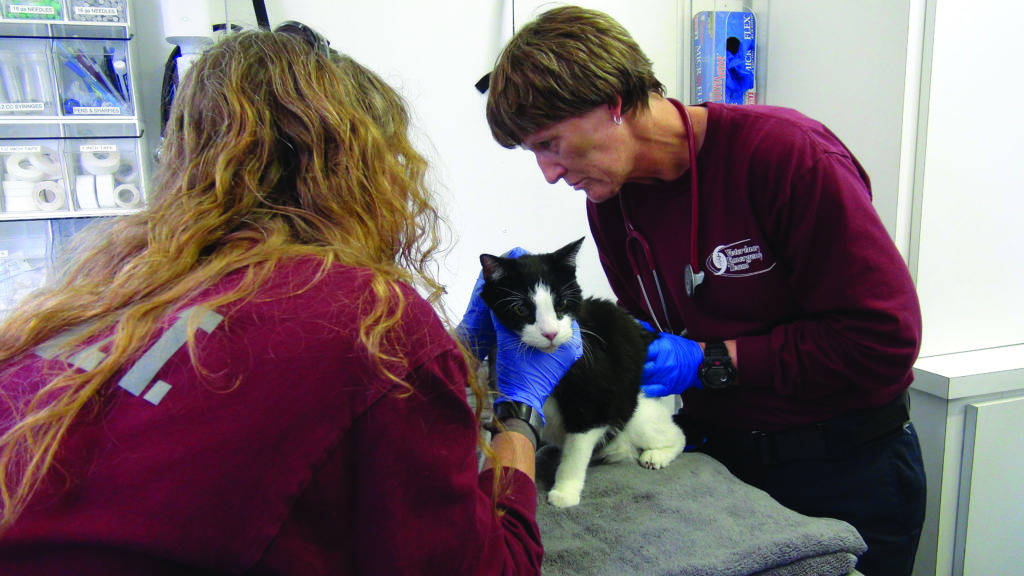Evacuating With Your Pets

Hurricane season isn’t over yet. In the wake of Hurricane Ike’s wrath, we are again reminded of the stress and chaos that can come from evacuations. Though a difficult time for everyone, pet owners have the added responsibility of making sure their furry (or scaly) friends are safe.
First and foremost, do not leave your pets behind. If the situation is not safe for you, it is not safe for them. There is no way of knowing how long the evacuation will last, or what damage your home might experience.
“Saving the Whole Family,” a brochure in the American Veterinary Medical Association’s disaster preparedness series, recommends planning ahead. Create a disaster kit that you can grab on your way out. Of course making sure your pet has food and water is the most important necessity for their survival, but there are a few very important, less obvious things you need as well.
The American Veterinary Medical Association recommends having these essentials in your disaster kit:
Identification- Make sure your pet has on ID. Whether it is a collar tag, microchip, temporary neckband, or tattoo, your animal’s identification needs to be visible to others in case they get lost. If they do not wear identification on a daily basis, have a form of ID in your disaster kit that is ready to be placed on your pet.
Transportation/Housing- Have carriers for all your animals. It is important to have a place to keep your animals in case you are not able to let them roam free once you get to your destination.
“Even if you are taking your pets to a friend or family member’s house,” says Dr. Debra Zoran, a veterinarian at Texas A&M University, “having a crate to keep your pet in is important to give them a sense of security as well as a place of refuge in the event there are problems between pets on the premises.”
When dealing with cats Zoran recommends having a crate large enough to hold their bed and litter box.
“The bigger the crate the better, the more the cat can move around the more comfortable it will be,” Zoran adds.
Veterinary records-Make photocopies of vaccination records and medical history and take them along. Keep the list of vaccinations your pet has received and the dates on which they were given. Also make sure to have a copy of their rabies certificate. In their medical history the AVMA suggests having important test results on file as well as a list of medical conditions.
Emergency contact list-This list should be prepared before an evacuation situation. Some basic numbers to include are your personal phone numbers, the number of someone that can be contacted in case you are not available, your veterinarian’s name, address, and phone number, a the information of a veterinarian where you will be evacuating to.
If you are evacuating with pets to a shelter, proof of ownerships is essential. Get photocopies of registration information, adoption papers, proof of purchase and microchip information to keep with you. Have a list of each animal’s species, breed, age, sex, color and distinguishable characteristics. It is also important to have current photos of your pets and pictures of you and your pet in case there is a dispute of ownership.
For more detailed information on these essentials, as well as extensive lists for pet disaster kits view the “Saving the Whole Family” brochure found at the American Veterinary Medical Association’s disaster relief website.
Having a disaster kit ready can help you be prepared for an evacuation, but the evacuation itself can be incredibly stressful on our pets.
If you get stuck in traffic Dr. Zoran recommends letting your pets out frequently, but have them on a leash at all times. Put the leash on your pet before you open the door.
“It is best to keep cats in their crates, but if you plan to let the cat out, make sure you have a harness for it to wear,” suggests Zoran, “If a cat is stressed and not in its crate, when you open the car door it can easily escape.”
Evacuating can be just as stressful for your pet as it is for you. Dr. Zoran suggests having their favorite toys and comfort items on hand can give them a sense of normalcy in the situation.
Prepare ahead of time for evacuations. Having a pet disaster kit ready to go at a moment’s notice can help make a stressful situation a little less traumatizing for you and your pet.
Pet Talk is a service of the College of Veterinary Medicine & Biomedical Sciences, Texas A&M University. Stories can be viewed on the Web at vetmed.tamu.edu/news/pet-talk. Suggestions for future topics may be directed to editor@cvm.tamu.edu.
Angela G. Clendenin
Director, Communications & Public Relations
Ofc – (979) 862-2675
Cell – (979) 739-5718


